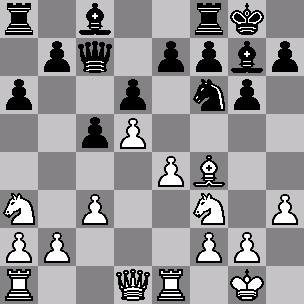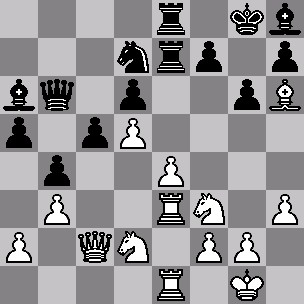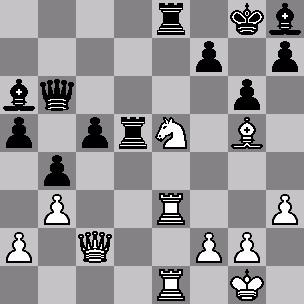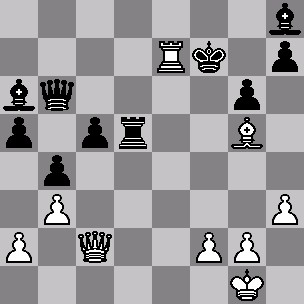20.12.2005
Round 2: Zvjaginsev-Khalifman
Live commentary by Konstantin Sakaev
Zvjaginsev, V (2659) - Khalifman, A (2653) [B20]
ch-RUS superfinal Moscow, Russia (2), 20.12.2005
1.e4 c5 2.Na3? Opening originality is certainly a good thing, but only when your novel ideas are not so artificial as this one. Of course, one can find some sense in this move: the c4-square can be a good square for White's knight in cases
2...Nc6?! In my opinion, this response is not very successful. Now White's idea 2.Na3 is partly justified as his light-squared bishop comes out to b5, and the knight should be able to enter the play via с4. If Black plays 2...g6 or 2...b6, White's idea is probably to transpose to the Alapin variation (с2-с3). Thus I think 2...b6! is a very interesting attempt for Black, which aims to force White taking care of his e4-pawn after 3.с3 Bb7.
3.Bb5 Qc7 4.Nf3 Now the knight's location on a3 is justified, although 0-0 would still have been more useful, planning to determine the route of the queen's knight later.
4...g6 5.c3 White could play more standard: 5.0-0 Bg7 6.Re1.

The only way to justify the preceding play.
7...Bg7! Taking the pawn is very dangerous: 7...Qxe4 8.Re1 Qd5 9.d4, and White's initiative is scary.
8.d4 d6 So, after the irregular opening the players arrived into a quite regular position, so both can be satisfied with the opening results, and escpecially Vadim - it is a great luck to play 2.Na3? and obtain a slightly better position.
9.d5 Qc7 10.h3 A useful prophylaxis; White must carry out е4-е5, so he does not allow Black to play Bc8-g4.
10...Nf6 11.Re1 0-0 12.Bf4

12...b5! Black can't prevent e4-e5, so the play like 12...Nd7 was doomed to be unsuccessful. Thus Black ignores the White's threat and develops his own play, underscoring an awkward location of the a3-knight.
13.Qd2 White decides to complete his development. Then he will probably play Rad1 and Nc2. Black will probably bring his bishop to b7, making the e4-e5 break impossible. An interesting position could arise after 13.e5 dxe5 14.Nxe5 Qb7 (White retains a minimal advantage after 14...Qb6 15.Nc6 e6 16.Ne7+ Kh8 17.Nxc8 Raxc8 18.dxe6 fxe6 19.Be5) 15.Nc6 e6 16.Bd6 Nxd5 17.Bxf8 Kxf8 18.Ne5 Qc7 - in my opinion, Black has full compensation for the exchange.
13...Bb7 14.Rad1 Rfe8 15.c4. This move only becomes useful if Black plays 15...bc4, helping White with his a3-knight. 15.Nc2 looked more logical: 15...e6 16.e5 Nxd5 17.exd6 Qd7 (other queen retreats should also be considered) 18.Bg3 f6 with complex struggle.
Let us take a look at the other games.
Svidler has a very small advantage after the 25th move. It is difficult to win such position. His move a4 raises doubts: it completely ruled out eventual b4 and c5. Black is close to equality... Oh, it is drawn already!
Kramnik-Volkov - a complex position with White's advantage, thanks to his strong pawn center and opponent's poor bishop on g6. Although the last Kramnik's move 0-0-0 is arguable. It is just a feeling, I haven't checked it with the engine.
Morozevich has a solid advantage against Rublevsky. The structure change strongly favored White. Black has worse pawn structure and bad light-squared bishop. He is in a very tough situation.
Almost the same can be said about Bareev-Jakovenko. Black's b8-knight and light-squared bishop are extremely passive. White has a long-lasting pressure.
Dreev has an advantage against Tomashevsky.
15...Qb6! Maintaining the tension. One could block the position with 15...e5 16.Bh6 b4, with even play; at the same time, 15...e6 is risky in view of 16.e5!
16.Bh6 Bh8! A correct decision! Exchanging the dark-squared bishops would have played into White's hands.
17.b3. An attempt to strengthen the central squares.
17...e6 18.Ng5 exd5 19.cxd5 Re7. 19...a5!? deserved attention, threatening a5-a4 somewhere and vacating the a6-square for the bishop.
20.Re3 Rae8 21.Rde1 a5 22.Nb1 b4 23.Qc2 Nd7 24.Nd2 Ba6 25.Ngf3

25...Ne5. Stronger was 25...Bc3! followed by f7-f6, but it is difficult to decide playing like this at the board. Now White will drive Black's rook away with Bh6-g5 after exchanging the knights, and will obtain a small advantage. However, I don't believe it will be anything serious.
26.Bg5 Nxf3+ 27.Nxf3. On 27.Rxf3 Black could play 27...Re5 28.Bf4 Rxd5.
27...Rd7 28.e5 This seems to lead to a forced draw.
28...dxe5 29.Nxe5 Rxd5

30.Nxf7 Rxe3 31.Rxe3 Kxf7 32.Re7+

32...Kf8? A mistake! Black could draw by 32...Kg8 33.Re8+ Kf7 34.Qe4 (or 34.Re7+ Kg8 35.Re8+ at once) 34...Qd6 35.Re7+ Kg8 36.Re8+ Kf7. On f8 the king appears vulnerable to a check from h6.
33.Qe4 Rd1+? One could still resist somehow after 33...Qd6 34.Bh6+ Bg7 35.Bxg7+ Kg8 36.f4 Bb5, although the resulting position is also difficult.
34.Kh2 Qd6+ 35.f4 Bf6 36.Bh6+ Kg8 37.Qa8+. Black resigned. 1-0
P.S. Vadik Zvjaginsev emplyed a fairly dubious idea, but nevertheless an interesting position emerged. Having reacted to not in the best way on the 2nd move, Alexander Khalifman continued the game excellently, and obtained a good play. Unfortunately, he blew the game in a time scramble and suffered a disheartening loss.
By exchanging queens in a time trouble, Dreev allowed a greater part of his advantage to slip away. He is still better, but the game should end in a draw. I also think that Jakovenko is close to a draw - there are too few pieces left. And Rublevsky should make a draw, too. He made a good move a6-a5 - White had no time to fix Black's pawns on light squares. Exchanges of rooks and knights were also in Black's favor. Kramnik has passed the control and he is absolutely winning. He handled this game very well.
Back to the Superfinal main page
